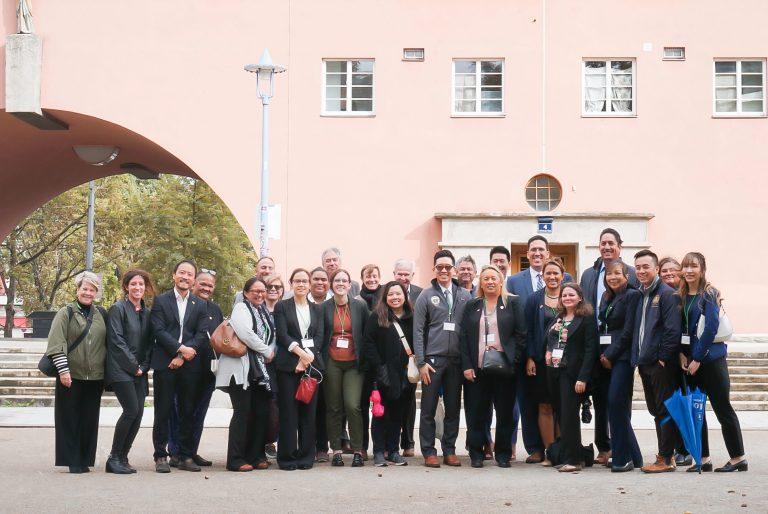Vienna, Austria, houses 60 percent of its population in beautiful, well-maintained, inexpensive social housing; in international studies, it ranks No. 1 in quality of life. Further, it spends half as much per capita on housing subsidies as California.
Yet despite billions in annual federal and state subsidies, California and Hawaii, among many other states, face severe shortages of affordable housing. As a result, the 2023 median single-family home prices in our respective districts in California and Hawaii are $1,340,000 (Milpitas, California) and $631,000 (Honolulu, Hawaii).
Last year, we traveled to Vienna to explore solutions to our respective housing shortages. Here are some of the key lessons we learned.
Government Bears Responsibility for Tenants’ Rights to Rental Housing
The United States housing system is organized around the private sector. The largest housing subsidy is the mortgage interest deduction, which benefits private developers, private mortgage lenders, and private homebuyers. In rental housing, the Low Income Housing Tax Credit (LIHTC) is granted to private developers, and Section 8 Housing Choice Vouchers are paid to private landlords.
About 160,000 California households confront court-ordered eviction every year. In Hawaii, it’s unlawful for a landlord to evict a tenant without a valid reason, ranging from delayed rent payments and overstaying the lease agreement to engaging in unlawful activities. But California tenants don’t have the same protection.
In Vienna, the public sector takes direct responsibility for housing the population. The city of Vienna is the landlord for 220,000 housing units, about one-fourth of the city’s housing stock, and oversees a further 200,000 housing units managed by the private sector.
Housing Finance: Recycling Funds Versus One-Time Use
LIHTC has been the backbone of new affordable housing construction in this country since its creation in 1986. LIHTC is not a loan, nor does it buy ownership in housing. It is a grant: free money to the developer. For projects that receive the 9 percent tax credit, the government pays for 70 percent of the project, but owns zero. The developer pays zero—the remaining 30 percent comes from a bank loan repaid by the rents collected from tenants. LIHTC funds disappear into the developer’s pockets every time a new building is built. As a result, capitalist America puts more taxpayer money into LIHTC every year, but falls further and further behind in its housing shortage.
It wasn’t until we visited Vienna that we realized just how much this legalized theft of government assets has hurt America’s housing production. Because of housing programs created in the first half of the 20th century, the city uses minimal new taxpayer funds to subsidize housing construction. Vienna’s housing fund was seeded long ago, and it is self-sustaining because it gives loans, not grants, that get repaid and are recycled to produce new housing. In addition, “limited profit housing associations” (LPHAs), which must use their profits to build more housing, control half of the city’s social housing.
READ ALSO:How should we regulate the real estate industry?
In the U.S., working within existing federal regulations, the simplest way to fix LIHTC would be for states to prioritize funding projects that give the equity either to the government or to nonprofits, who are then obligated to use their profits to produce more housing. Such a change would not even require a legislative action, but only administrative changes to the prioritization of LIHTC applications, known as the Qualified Allocation Plan (QAP).
Even so, some agencies are reluctant to embrace this change. To address this issue, Sen. Chang introduced SB 858 (2023) and SB 859 (2023) to amend Hawaii’s QAP to prioritize LIHTC applications for state-owned projects, LPHAs, and projects with early loan repayment. If enacted, these bills will ensure that taxpayer dollars will be used for publicly owned projects and private projects that recycle taxpayer funding, rather than projects owned by private entities for their own benefit.
Housing for All Rather Than Only the Poorest
A perhaps even more important lesson is Vienna’s focus on the middle class. In America, government-subsidized housing targets the very poor: public housing requires tenants to make less than 80 percent of the area median income (AMI) and Section 8 rental vouchers cap income at 50 percent of AMI, while LIHTC caps fall between these limits. Because many of these tenants are too poor to pay rents that would cover the construction, operation, and maintenance costs of a building, the government must subsidize the large gap. In California coastal urban regions, constructing housing for low-income households costs at least $165,000 per unit in subsidies, and likely higher.

In Vienna, the housing agencies don’t build housing just for the poorest. The rents of each new project must cover its development and ongoing expenses, so most tenants must have the capacity to pay those rents. Those with low incomes may receive rent subsidies. In return, tenants have the right to live there as long as they live, and may even pass their apartment down to their children.
READ ALSO: Middle-Income Earners Face Challenges in Acquiring Homes Amidst Surging Housing Costs
Vienna does impose an income limit on new tenants of social housing, but it is inclusive, allowing 75 percent of the population to qualify, and it applies only at the beginning of their tenancy. By focusing on housing for all rather than prescribing specific income ranges, each unit requires only a modest subsidy in the form of a low-interest, long-term government loan, which means the program is scalable to actually produce enough housing to meet demand.
Public Lands for Public Housing
Some recent or proposed uses for surplus state lands in the urban core in our states include office space for state workers and a hotel and luxury condo development. These plans show that our states aren’t serious about ending the housing shortage. By contrast, Vienna converted disused rail yards near its main station into an urban neighborhood with 5,500 apartments for 13,000 residents, a park, and work space for 20,000. Vienna is also redeveloping a 800-acre former airfield into a mixed-use urban center with housing for 25,000 residents. In both instances, social housing forms the core of the development.
Services and Amenities Integrated into Housing
While 20th-century American public housing projects prioritized keeping construction costs as low as possible, without additional services, Vienna has a long history of integrating services like medical offices, kindergartens, retail stores, and access to public transportation into housing projects. This tradition originated to address the overcrowded, substandard housing of the early 20th century. Today, the scale of the large government parcels enables a truly lavish array of amenities, like an artificial lake, rooftop pools, a theater for plays and concerts, and schools and libraries. Indeed, Vienna’s government told us that social housing is actually higher quality than private housing. By contrast, public housing in the U.S. is notoriously underfunded, poorly maintained, and far from lavish.
Legislative Takeaways
We are now working on legislation to adapt Vienna’s housing model to address the severe housing shortages in our states. In California, Assembly member Alex Lee introduced AB 309 (2023), which creates California’s own social housing authority to build up to three mixed income social housing projects on state owned land. In evaluating bids for these projects the housing authority will prioritize revenue neutrality and utilize both rental and ownership approaches. The bill prohibits cities or counties from rejecting approved social housing projects but permits them to suggest design standards and safety modifications.
Elsewhere in California, school districts are converting excess properties into teacher housing, transit authorities are developing affordable housing on disused parking lots near transit stations, and an increasing number of public entities are acting as land banks and public developers. Through these initiatives, the state of California will assume a far greater role—and therefore responsibility—in providing the housing needed to meet its citizens’ demand.
Hawaii State Sen. Stanley Chang has introduced three bills modeled on Viennese social housing. He introduced SB 1462 (2023) to form a working group to establish LPHAs, modeled after Vienna’s, to build subsidized housing and recycle their profits to build more. These LPHAs would receive priority in allocation of LIHTC and state Rental Housing Revolving Fund subsidies. Sen. Chang’s ALOHA (Affordable, Locally Owned Homes for All) Homes program was also recently signed into law. SB 865 (2023) creates a pilot program to build owner-occupied housing. Key components of the program, including income blindness and revenue neutrality, are based on Vienna’s social housing model.
If our states adopt these measures and adjust existing housing subsidy programs to prioritize income-blind, revenue-neutral housing like the Viennese model, Hawaii and California can fill a critical missing piece of our social contract: housing for all.
Source: Shelterforce



